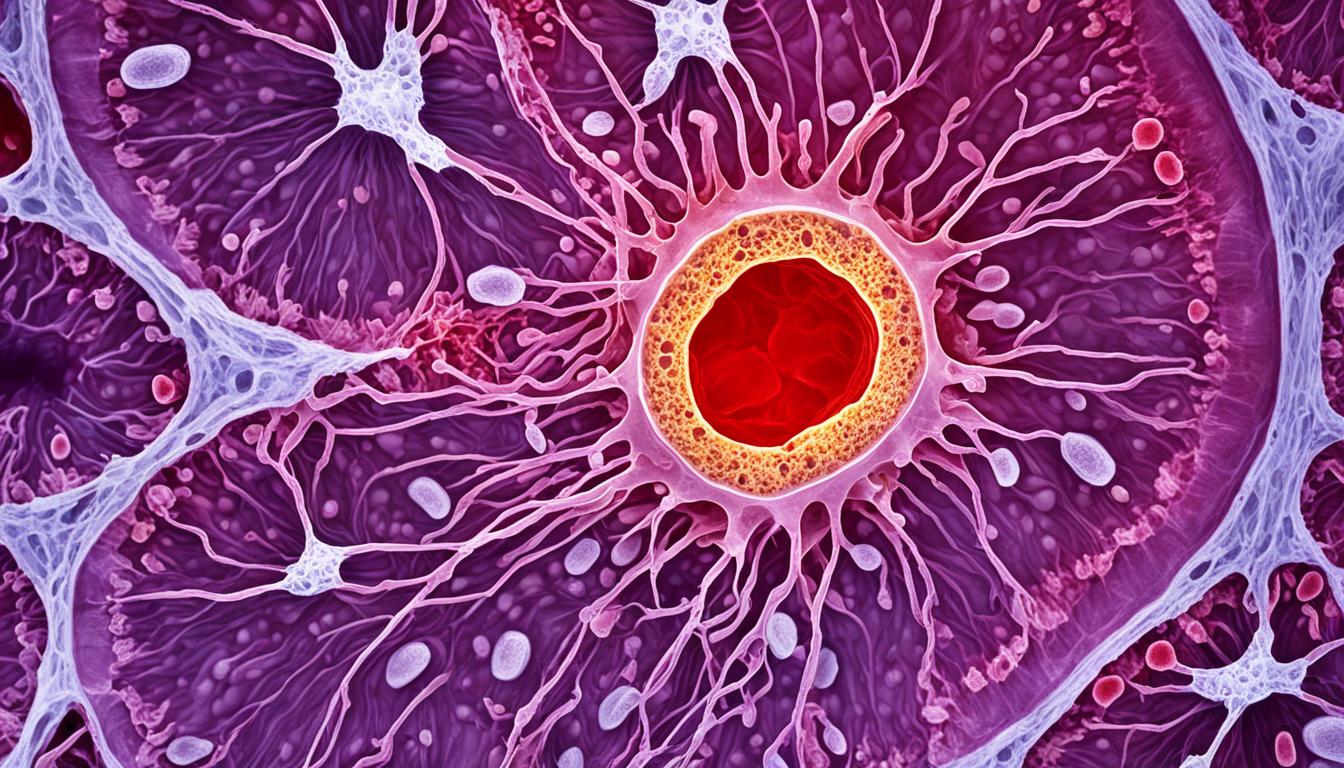Nephrotic syndrome is a kidney disease that makes the body lose too much protein through urine. This leads to swelling, changes in urine, and a higher risk of blood clots. The sickness affects the tiny filtering parts of the kidneys, known as glomeruli. It makes it hard for the kidneys to keep fluid balance right and get rid of wastes. As a result, the body can hold too much fluid, causing swelling and other problems.
The sickness can be caused by different things like infections, certain drugs, or issues during pregnancy. Sometimes, doctors can’t find the exact cause, even after a lot of tests. It’s then called idiopathic. Nephrotic syndrome is split into two main types. The first is when the kidney damage is the main problem. The other type is when the kidney damage is due to another health issue.
Doctors diagnose nephrotic syndrome by checking for common signs. These include too much protein in the urine, swelling, and changes in blood protein levels. They might also do blood tests and a kidney biopsy. These tests help figure out how well the kidneys are working and what’s causing the problem.
Treatment for nephrotic syndrome is about reducing symptoms, preventing problems, and slowing down kidney damage. The right treatment depends on what’s causing the syndrome and how bad it is. Common treatments include medicines like corticosteroids to lower protein levels and reduce kidney inflammation. Doctors might also use diuretics, recommend a high protein diet, or prescribe drugs to control high blood pressure.
Stem cell therapy is a new area of treatment being looked into for nephrotic syndrome. This way of treating the illness uses special cells to help damaged kidneys heal and work better. Even though this treatment is still being studied, it looks like a hopeful option for the future. It aims to offer a treatment that’s more direct and effective for nephrotic syndrome.
Key Takeaways:
- Nephrotic syndrome is a kidney disease characterized by protein loss in the urine, leading to swelling and other symptoms.
- The causes of nephrotic syndrome can include infection, medication, and pregnancy toxicity.
- Diagnosis is based on clinical signs such as proteinuria and edema.
- Treatment options include corticosteroids, immunosuppressive therapy, and symptomatic management.
- Stem cell therapy holds potential as a future treatment for nephrotic syndrome.
Understanding the Genetic Basis of Steroid-Resistant Nephrotic Syndrome (SRNS)
Steroid-Resistant Nephrotic Syndrome (SRNS) does not react to steroids. It is usually due to genetic changes, especially in the NPHS2 gene. This gene helps make a protein named PODOCIN, crucial for kidney filtering.
Scientists have used gene editing to make these genetic changes in tiny kidneys from stem cells. By looking at these mini-kidneys, they found that changes in the NPHS2 gene cause less PODOCIN. This affects the location and work of PODOCIN in cells. It leads to cell death and harms the kidney’s filtering function in SRNS patients.
Using mini-kidneys from stem cells has been key in understanding SRNS’s genetics. By copying the genetic issues and seeing their impact on kidneys, we learn more about the condition. This insight helps in creating treatments that target the specific genetic problems in SRNS.
The Role of Gene Editing Techniques and Mini-Kidneys
Gene editing has changed how we recreate genetic SRNS mutations in labs. This process is done in mini-kidneys from stem cells. It mimics the genetic issues in SRNS patients and helps understand how these changes harm kidney functions.
These techniques have shown how NPHS2 gene mutations affect PODOCIN. They have given major insights into how SRNS develops and worsens.
Further Advancements in Understanding SRNS
Working with mini-kidneys from stem cells continues to improve our understanding of SRNS. By studying these organs, scientists learn how different genetic mutations affect the kidneys. This leads to treatments made to fit each patient better, potentially changing how we manage SRNS.
| Advancements in Understanding SRNS | Benefits |
|---|---|
| Replication of NPHS2 gene mutations | Provides insights into genetic abnormalities associated with SRNS |
| Observation of PODOCIN alterations | Enhances comprehension of the protein’s role in kidney filtration and its impact on SRNS |
| Exploration of disease mechanisms | Facilitates the development of targeted therapies for SRNS |
Potential Impact of Stem Cell Research on Nephrotic Syndrome Treatment
Stem cell research is making a big difference in how we treat nephrotic syndrome. This disorder affects the kidneys and occurs in both kids and adults. Scientists are growing kidneys from stem cells in labs. This helps them understand the disease better and find new ways to treat it.
A special kind of nephrotic syndrome called Steroid-Resistant Nephrotic Syndrome (SRNS) often affects kids. Scientists are using advanced techniques to study this disease. They make mini-kidney organoids to look closely at SRNS. This work helps them see the genetic causes of the disease. It guides the development of treatments that work directly on these causes.
Kids with nephrotic syndrome, especially those with SRNS, might need kidney transplants. But, stem cell research is changing this. It’s deepening our knowledge of the syndrome. And it’s aiming to find better treatments. This could mean fewer kids need transplants in the future.
Creating kidneys from stem cells gives scientists a way to closely study nephrotic syndrome. They can understand the disease in detail. This could lead to treatments that are tailored for each patient. This research is promising to change the way we deal with nephrotic syndrome. It could significantly help those with the disorder, from children to older adults.

